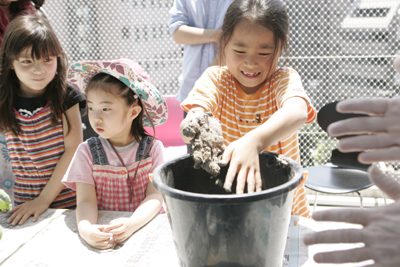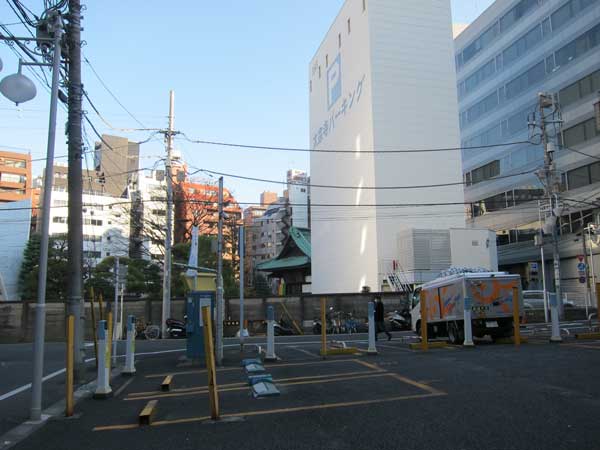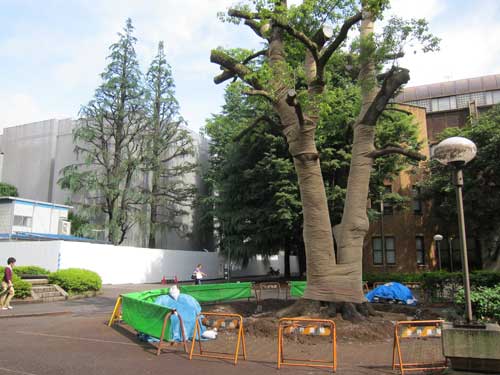
外国産の背が高いヤシの木は大きい庭の境界線にとてもすてきです。
Few homes in Tokyo have lawns, let alone a row of tall exotic palms. If I’m not mistaken, these may be butia palms from South America. What a cool garden. Near Sangubashi.

最近、クスノキという巨大な木について知りました。中伊豆で見たものは、幹に苔がいっぱい生えていました。東京のオフィス・タワーの前にも、もっと乾燥したクスノキを見つけました。とても素敵だと思います。
I recently noticed this giant evergreen tree called camphor (or kusunoki in Japanese). A single, well cared for tree can easily become a local landmark. The above tree is in a mountaineous area of Izu. Below in front of a glass and metal tower in Shiba, across from Tokyo Tower.


東京湾のあたりは50年前に、高速道路と公園のようなインフラをたくさん作りました。全く使われていない不毛の空間ときれいな場所が同時に存在しています。雑草と偶然にできた緑の空間が生き残ります。
I often show images of the long cherry tree path that leads from Tatsumi’s subway to the municipal swimming pool. The 10 minute walk mixes all that’s both beautiful and dirty about 1960s infrastructure projects. There’s the amazing public sports facility, a now mature park with tall trees bordering the elevated freeway, and an odd mix of new construction, prior buildings, and informal green spaces that benefit from a lack of attention.



東京の夏は、草の背が高くなってたくさん茂ります。この売り出し中の空き地に、コウモリがよく来ます。いまのところ、虫が多そうです。コウモリには都合がいいですね。
A Tokyo summer quickly produces thick and tall weeds. These two empty lots are for sale near our house. In the meantime, they are supporting a large insect population, and attracting bats. There’s something wonderful about this temporary nature spot.

千葉の御宿に着くと、きれいなヤシの並木が見えます。細くて背が高いです。カリフォルニアに人気なメキシコのヤシみたいです。急行で行くと、東京から御宿は近いです。電車からの東京湾の景色が大好きです。
I love how this row of skinny palm trees greets visitors to Onjuku, Chiba right from the station. They look like Mexican fan palms (washingtonia robusta) which are very common in California.
Onjuku is an 80 minute ride on the express train, and the beach is a 10 minute walk away. It’s great to visit the beach even for an afternoon. The trip by train is also fun. I love to see the port buildings and activities.



The rooftop garden of the new Tokyu Plaza Omotesando Harajuku mall, the one with the fun house, crazy mirror escalator entrance, it is much more lively than I expected. On a nice day, it draws a large crowd to relax and chat in the shade. I am impressed with the generously tall size of the trees, the irregular openings of the deck for plantings, and the many levels that provide seating and variation. The roof garden is partly visible from the sidewalk, unlike the older department store roof gardens, and forms part of the architecture of the building. Perhaps that’s why it’s more discoverable and popular.
 .@ShibauraHouse の子供たちのワークショップのために、この種爆弾のレシピを書きました。五種類の種を使いました。人と動物の食べられる植物を選んで、背の高い花は見えやすいので選びました。子供が粘土と土と種を混ぜて、汚れるときが楽しかったようです。
.@ShibauraHouse の子供たちのワークショップのために、この種爆弾のレシピを書きました。五種類の種を使いました。人と動物の食べられる植物を選んで、背の高い花は見えやすいので選びました。子供が粘土と土と種を混ぜて、汚れるときが楽しかったようです。
This is the handout I made for the Shibaura House seed bomb workshop for kids. The recipe is 5 parts powdered clay, 2 parts soil, 1 part seed, and 1 part water. Thinking about the season, late spring, just before rainy season, I chose clover, soba, sunflower, hollyhocks, and watermelon.
The seed selection also responded to the theme of “eating and seeing green.” I wanted to provide food for animals as well as people, as well as flowers that are tall and easy to see. The soba and clover seeds are the least expensive and served as the seed “base.”
Corrected: Below are photos from the event, taken by Naomi Muto and written up by Shirakuma Ikuko in Japanese. It’s funny that my instructions were to make balls (dango), but the kids enjoyed making shapes like stars, bows, donuts, Jupiter, and even a black hole.





In the afternoon, the adults who attended the kick-off talk event also participated in vegetable planting on the 4th floor. Shibaura House is tweeting the growth of their new garden!


In Shibuya’s Mitake park, four men are pruning the trees. They are using a tall ladder and also a cherry picker. I appreciate skilled labor.

仮設の半永久的な駐車所はお寺やオフィスビルやマンションに囲まれています。高いエレベーターの駐車場はお寺の土地を使っているそうです。
In the foreground, there’s an automated surface parking lot on a lot that may get developed. The tall white structure is an elevated parking lot that is semi-permanent, and it appears to have been erected on the property of a fairly large temple and graveyard. On either side, offices and apartment buildings frame a dense and changing city.

I love how this Nishi Azabu corner house has maybe 25 centimeters of space and a three-story tall garden of mature trees and bushes. The deciduous trees provide summer shade, and in winter the bare branches have a different appeal.

 東京の中には、たくさんのあまりきれいでないものがあります。とても高い電線は江戸時代の五日市街道の上を渡ります。ごみ焼却炉の煙突や高架道路やマンションの終わらない蛍光灯の列も都市生活に奇妙なリズムをつくります。このとても高い電線の下に柿の実が見えます。
東京の中には、たくさんのあまりきれいでないものがあります。とても高い電線は江戸時代の五日市街道の上を渡ります。ごみ焼却炉の煙突や高架道路やマンションの終わらない蛍光灯の列も都市生活に奇妙なリズムをつくります。このとても高い電線の下に柿の実が見えます。
There are many urban sights in Tokyo that are jarring to newcomers, perhaps none more so than the giant electricity poles. Well, there’s also garbage incinerators with tall chimneys in every neighborhood, elevated freeways, endless rows of fluorescent lights stacked high on exposed residential hallways, and the zeal for paving over almost all surfaces.
This photo was taken near Shin Koenji where the elevated main power line crosses Itsukaichi Kaido, a road that dates back to Edo and maybe earlier. You can just make out a silhouetted ripe persimmon fruit. Sometimes these unattractive elements create their own rhythm and patterns in urban life.

I love these bright red spider lilies, called higanbana in Japanese. They bloom in September with tall stalks, bright flowers, and no leaves. They come back each year along this pedestrian path, and the flower lasts only a week or so. Last year, too, I saw them everywhere in Tokyo. I like how they mark the turn of season.

スカイツリーはほとんど出来上がりました。英語をしゃべる人にこの片仮名の名前はちょっと変です。錦糸町駅で写真をとりました。
Sky Tree, Tokyo’s tallest landmark, will be finished at the end of this year, and opening next spring. In Japanese it’s pronounced Sukai Tsurii. This is the view from Kinshichou station just south of the tower.

東大法学大学院の新しい図書館ができるまで、成熟したイチョウの木を移動しています。 東大は木の価値に気がついていて、うれしいです。本郷のキャンパスの背の高い木や三四郎池はとてもすてきです。
It’s wonderful to see how the University of Tokyo is carefully removing two mature ginko trees as it breaks ground for a new law school library. The Hongo campus is gorgeous, both for its brick buildings that are vaguely ivy league and art deco, but also for its stunning trees and Sanshiro pond.
The frantic pace of construction and reconstruction has left Tokyo with an inadequate tree canopy. It’s great that these two trees will survive the new building, and that the University of Tokyo demonstrates that it values its natural environment.

Taking care of bonsai trees makes you pay more attention to details. I love how this tiny Japanese maple’s shadow accentuates its twisty, thin trunk. I am thinking about how best to prune it once the leaves get bigger. I don’t want it to get too tall or too full around the length of the trunk. This is my first bonsai, purchased last summer at Sinajina. There’s an older post of its fall foliage.